Brewing Beer with Coffee Malt
Published: July 28, 2025 at 6:37:02 AM UTC
Last updated: December 9, 2025 at 6:53:09 PM UTC
Brewing beer with coffee malt is a unique process that combines the rich flavors of coffee with traditional brewing techniques. This method results in a sweet, mild roast flavor with less bitterness. It offers a distinct taste experience. To achieve this unique flavor profile, understanding coffee malt's fundamentals is key. The right coffee variety and roast level are critical for the final product.
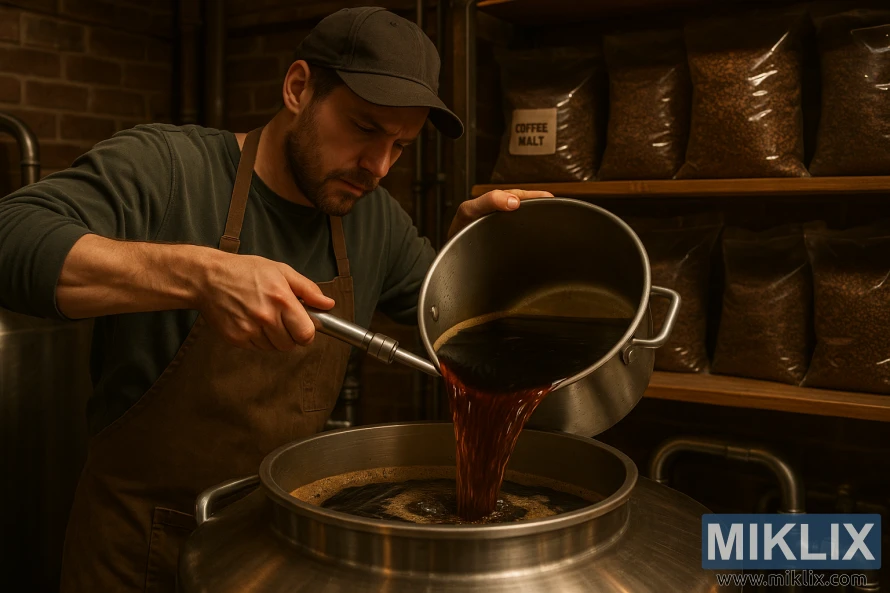
Key Takeaways
- The use of coffee malt in brewing beer creates a sweet and mild roast flavor.
- Less bitterness is a characteristic of beer brewed with coffee malt.
- Selecting the appropriate coffee variety is critical for the desired flavor.
- The roast level of the coffee significantly impacts the beer's taste.
- Understanding coffee malt's characteristics is essential for successful brewing.
Understanding Coffee Malt Fundamentals
Unlocking coffee malt's full brewing capability requires understanding its fundamental properties. This specialty malt, infused with coffee flavors, can significantly enhance beer quality. It's a unique ingredient that can take beer to new heights.
Coffee malt is created by blending malted grains with coffee. This blend captures the essence of both, making it a standout in brewing. The brewing process with coffee malt mirrors coffee brewing in terms of extraction. Like coffee, there's an optimal extraction point for coffee malt to achieve the desired flavors.
- The type of coffee used to infuse the malt
- The roast level of the coffee and its impact on the beer's flavor
- The proportion of coffee malt to other grains in the recipe
- The brewing techniques that optimize the extraction of coffee flavors
Grasping these fundamentals is key to achieving a sweet, mild roast flavor in beer without bitterness. By mastering coffee malt's interaction with other brewing ingredients, brewers can craft unique, high-quality beers. These beers showcase the best of coffee malt.
The History of Coffee Malt in Brewing
The use of coffee malt in beer brewing has a rich history, marked by brewers' creativity. It began with early experiments with unique ingredients. Brewers were always looking to push the limits of what was possible.
The inspiration for coffee beer brewing came from beers like Founders Breakfast Stout. This stout showed how combining coffee and beer could lead to something new and exciting. It changed the way people thought about craft brewing.
As time went on, brewers started experimenting with different roasts and brewing methods. They aimed to capture the sweet flavor of coffee in their beers. This led to a wide variety of coffee-infused beers, appealing to many different tastes.
The journey of coffee malt in brewing highlights brewers' adaptability and innovation. It shows their dedication to creating unique beer experiences.
Characteristics of Quality Coffee Malt
The essence of quality coffee malt significantly influences the taste of your beer. It's vital for achieving a sweet, mild roast flavor. This malt boasts a rich taste and aroma, with hints of chocolate, caramel, and nuts.
Choosing high-quality arabica beans is key for brewing coffee beer. Brewmasters agree that arabica beans are preferred, often sourced from places like Mexico, Sumatra, and Rwanda. The coffee's origin greatly affects the beer's flavor.
Quality coffee malt should have a distinct aroma that enhances the beer without dominating it. Its flavor should be complex, balancing sweetness and roasted notes. Using premium coffee malt can significantly improve the beer's character, appealing to diverse tastes.
- Rich flavor profile with notes of chocolate and caramel
- Aroma that complements the beer without overpowering it
- Balance of sweet and roasted notes
- High-quality arabica beans
By prioritizing these traits, brewers can craft beers that highlight coffee malt's unique qualities. Whether brewing a coffee stout or porter, the malt's quality is critical to the beer's success.
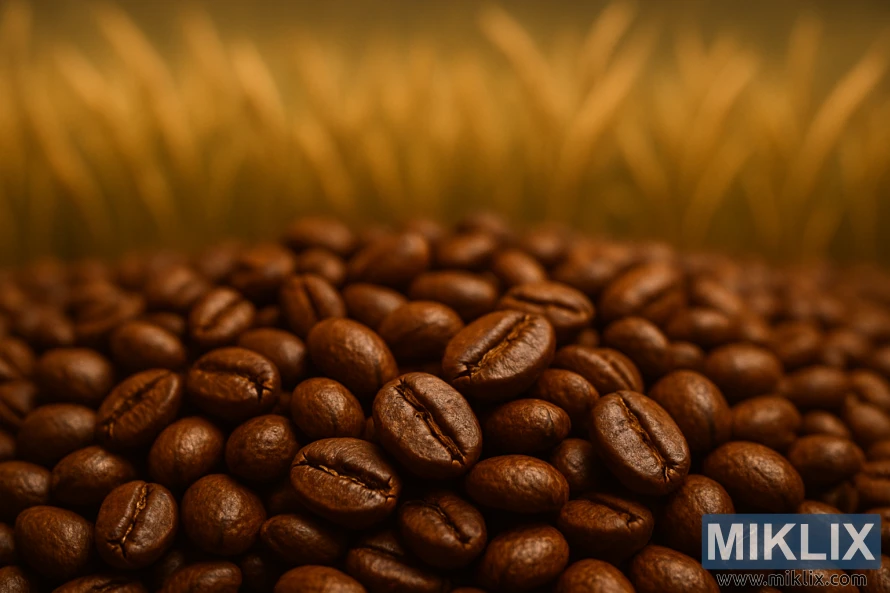
Selecting the Right Coffee Malt for Your Beer
The choice of coffee malt is key to your beer's flavor, making it a critical step in brewing. With a variety of coffee types and roast levels, brewers have many options. This selection can greatly impact the taste of your beer.
The type of coffee used significantly affects the beer's flavor. Arabica coffee offers mild, nuanced flavors, while Robusta is known for its bold, bitter taste. Brewers should pick a coffee malt that complements their beer's style.
The roast level of the coffee malt is also vital. Lighter roasts keep more of the coffee's natural acidity and flavor nuances. Darker roasts, on the other hand, bring out deeper, richer flavors. The choice of roast level depends on the desired taste of the beer.
- Coffee Variety: Consider whether Arabica or Robusta suits your beer's style.
- Roast Level: Decide on the roast level based on the desired flavor profile.
- Flavor Profile: Think about how the coffee malt will interact with other ingredients in your beer.
By carefully considering these factors, brewers can choose a coffee malt that enhances their beer's unique characteristics. Whether you're brewing a coffee stout or a coffee porter, the right coffee malt can elevate your beer to the next level.
Essential Equipment for Coffee Malt Brewing
The art of coffee malt brewing requires specific equipment. This gear is vital for achieving the perfect flavor and quality in your coffee malt beers.
Having the right equipment can greatly impact the brewing process. To brew coffee malt beer, several key pieces are necessary.
- Coffee grinders for grinding coffee beans
- Coffee brewers for brewing coffee
- Fermenters for fermentation
Different brewing methods demand different equipment. For example, the "dry beaning" method involves adding whole coffee beans directly to the fermenter.
Conversely, cold brew integration requires soaking coffee beans in room temperature water for 24-48 hours. Knowing these methods and having the right equipment is essential for successful coffee malt brewing.
Preparing Your Coffee Malt for Brewing
Roasting and grinding are key steps in preparing coffee malt for brewing. The quality of your coffee malt beer greatly depends on these processes. Roasting coffee to the right level enhances the flavors and aromas that will enrich your beer.
To effectively roast your coffee malt, understanding different roast levels is essential. For example, roasting arabica coffee until the inner oils just start to show on the surface can add a rich, full-bodied taste. The grind size of your coffee malt also plays a significant role, impacting the extraction rate during brewing.
- Choose the right roast level based on the beer style you're brewing.
- Grind your coffee malt to the appropriate size for optimal extraction.
- Store your roasted and ground coffee malt in an airtight container to preserve freshness.
By meticulously preparing your coffee malt, you can enhance the complexity and balance of your beer's flavor. Whether you're crafting a coffee stout or a coffee-infused ale, the preparation of your coffee malt is a critical step. It can significantly elevate your brew to new heights.
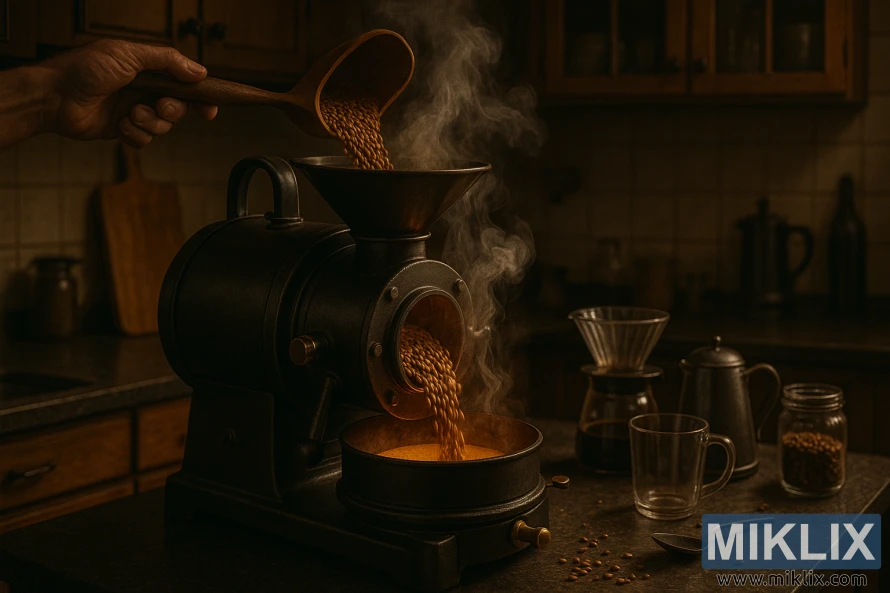
The Perfect Mash Temperature for Coffee Malt
Mash temperature is a critical factor in coffee malt brewing, affecting the intensity of the coffee flavor. The perfect mash temperature for coffee malt is essential for achieving a sweet, mild roast flavor.
A higher mash temperature results in a more intense coffee flavor, while a lower temperature yields a milder taste. Brewers must carefully balance the mash temperature to extract the desired flavors from the coffee malt.
To achieve the optimal mash temperature, brewers should consider the type of coffee malt being used and the desired flavor profile. Experimenting with different mash temperatures can help brewers find the perfect balance for their coffee malt beers.
- A higher mash temperature can enhance the coffee flavor.
- A lower mash temperature can result in a smoother taste.
- The type of coffee malt used affects the optimal mash temperature.
Water Chemistry and Coffee Malt Interaction
Mastering the perfect beer flavor requires a deep dive into water chemistry and its interaction with coffee malt. Water chemistry is a critical factor in brewing, significantly impacting the beer's flavor profile.
The relationship between water chemistry and coffee malt is complex. Different water chemistry profiles can either complement or clash with the coffee malt's characteristics. For example, water with high alkalinity can neutralize some of the acidity in the malt. On the other hand, water with high levels of certain minerals can enhance the malt's flavor notes.
When brewing with coffee malt, brewers must consider several aspects of water chemistry:
- The pH level of the water, which affects the extraction of flavors from the coffee malt.
- The mineral content, including calcium, magnesium, and sodium, which can influence the beer's flavor profile.
- The alkalinity of the water, which can impact the beer's overall balance and stability.
Different beer styles require distinct water chemistry profiles. For instance, brewing a stout with coffee malt may need a different water chemistry profile than brewing a pale ale with the same malt. Understanding these requirements is essential for achieving the desired flavor profile in the finished beer.
To optimize water chemistry for coffee malt brewing, brewers can:
- Adjust the water's pH level by adding specific salts or acids.
- Modify the mineral content to enhance or mute certain flavor characteristics.
- Use water treatment processes to achieve the desired alkalinity and mineral profile.
By carefully managing water chemistry and its interaction with coffee malt, brewers can create beers with complex and balanced flavor profiles. These beers showcase the unique characteristics of the coffee malt.
Balancing Coffee Malt with Other Grains
To perfect the flavor, brewers must balance coffee malt with other grains. The grain selection greatly influences the beer's taste, with each grain fitting specific styles. This balance is essential for achieving the desired flavor profile.
Coffee malt is ideal for dark beers like porters and stouts. Its deep, roasted notes enhance the beer's overall character. Brewers should choose grains that complement coffee malt's unique flavor.
A balanced grain mix might include base malts, specialty malts, and coffee malt. For instance, a brewer might start with pale malt as the base. Then, they add Munich or Victory malt for depth. Coffee malt is added last to give the beer its distinctive taste.
- Consider the flavor profile you want to achieve.
- Choose base malts that will complement the coffee malt.
- Use specialty malts to add complexity.
By balancing coffee malt with other grains, brewers craft complex, nuanced beers. This approach highlights coffee malt's best qualities. Effective grain selection is critical for achieving a harmonious flavor balance.
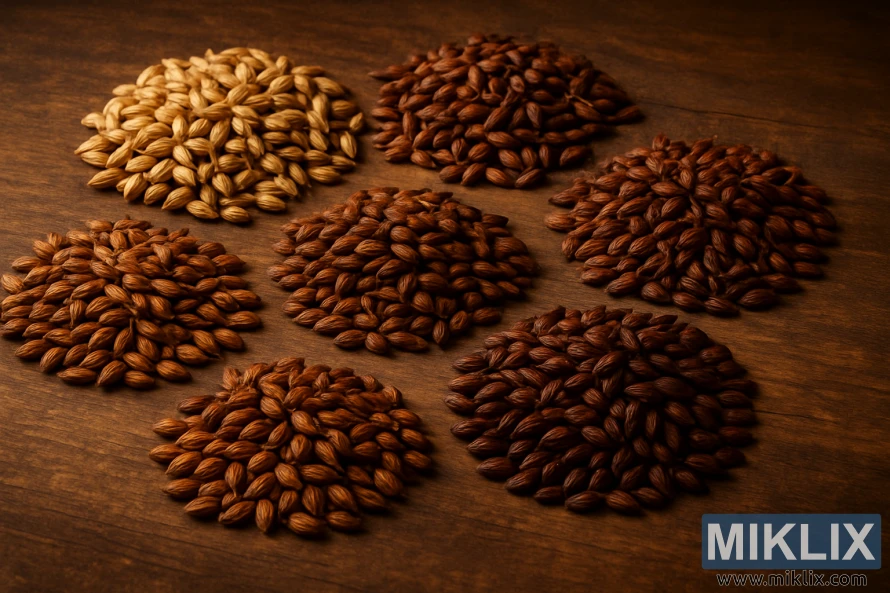
Fermentation Considerations for Coffee Malt Beers
Fermentation is a critical step in brewing coffee malt beers, as it directly impacts the final flavor profile. The fermentation temperature is a key factor brewers must control to achieve the desired flavor characteristics.
Experts agree that the fermentation temperature greatly affects the extraction of coffee flavors from the malt. A higher temperature can result in a more intense coffee flavor. On the other hand, a lower temperature can lead to a milder flavor.
To manage fermentation effectively, brewers should consider the following key factors:
- Monitor and control fermentation temperature to achieve the desired flavor profile.
- Select a yeast strain that is suitable for coffee malt brewing and can handle the unique flavor compounds.
- Ensure proper sanitation and hygiene practices to prevent contamination and spoilage.
By carefully managing the fermentation process, brewers can create coffee malt beers with complex and balanced flavor profiles. These beers showcase the unique characteristics of the coffee malt.
Managing Bitterness Levels in Coffee Malt Brewing
Reaching the perfect flavor balance in coffee malt brewing is all about managing bitterness. Bitterness is key to the taste of your beer. It can either elevate or ruin the flavor profile.
To control bitterness, focus on two main aspects: the roast level and grind size of the coffee malt. The roast level greatly affects bitterness. Lighter roasts are often more bitter, while darker roasts are less bitter but add other flavors.
- Adjusting the roast level to suit your beer style
- Experimenting with different grind sizes to optimize bitterness extraction
- Balancing coffee malt with other grains to achieve a harmonious flavor
The grind size of the coffee malt also impacts bitterness. A finer grind can make the beer taste more bitter due to better extraction. On the other hand, a coarser grind results in a smoother, less bitter taste.
By adjusting these factors, brewers can fine-tune the bitterness in their coffee malt beers. This leads to a balanced and enjoyable drinking experience.
Achieving Sweet Coffee Notes Without Overwhelming Roast
Creating a perfect balance between sweet coffee notes and roast flavors is key in coffee malt brewing. It's essential for brewers to pick and roast their coffee malt with care. This ensures the desired sweet coffee flavors are brought out.
The type of coffee beans used greatly affects the sweetness and roast level of the beer. Arabica beans, for example, offer a sweeter and more complex flavor compared to Robusta beans.
- Opt for a coffee malt with a lighter roast to keep the natural sweetness intact.
- Pair the coffee malt with other grains to avoid being overwhelmed by roast flavors.
- Keep a close eye on the brewing process to prevent over-extraction, which can make the beer bitter.
By grasping the characteristics of their coffee malt and managing the brewing process well, brewers can create beers. These beers will highlight sweet coffee notes without being overpowered by roast flavors.
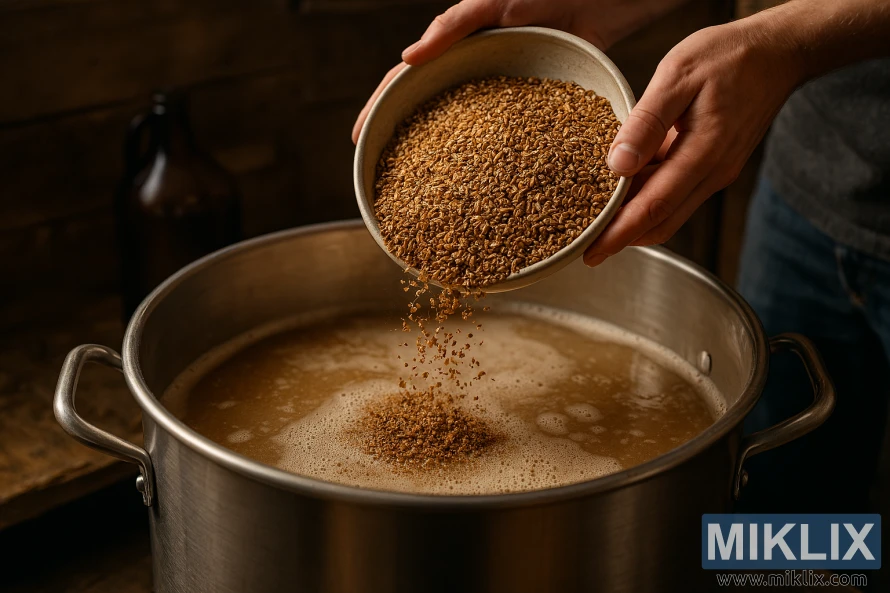
Common Coffee Malt Brewing Mistakes to Avoid
To brew great beer with coffee malt, understanding and avoiding common mistakes is key. Brewing with coffee malt introduces unique flavors and complexities. But, it also presents challenges that can affect the final product's quality.
One of the most significant mistakes brewers make is over-extraction. Over-extraction occurs when too much of the coffee malt's compounds are extracted into the beer. This leads to an unbalanced flavor. It can happen if the mash temperature is too high or if the grains are steeped for too long. To avoid this, brewers should carefully monitor their mash temperatures and adjust their brewing time.
Under-extraction is another common issue. This happens when not enough of the desirable compounds are extracted from the coffee malt. As a result, the beer lacks the intended coffee flavor. Ensuring the right mash temperature and sufficient steeping time can help prevent under-extraction.
Incorrect roast levels can also significantly impact the beer's flavor. Using a coffee malt with a roast level that doesn't match the brewer's intent can lead to undesirable flavors. For example, using a very dark roast in a beer meant to be light and crisp can overwhelm the other flavors.
To avoid these common mistakes, brewers should also consider the interaction between coffee malt and other ingredients in their recipe. Balancing the coffee flavor with other grains and hops is critical for creating a harmonious taste experience.
- Monitor mash temperatures to avoid over-extraction.
- Adjust brewing time to prevent under-extraction.
- Choose a coffee malt with a roast level that fits your beer's style.
- Balance coffee malt flavors with other ingredients.
Aging and Conditioning Coffee Malt Beers
Aging and conditioning are key steps in brewing coffee malt beers. They allow the flavors to mature and blend. This process can enhance the beer's complexity, with coffee notes softening over time.
For optimal results, brewers must consider several factors. The beer should be kept in a cool, dark spot to avoid spoilage and off-flavors. Also, brewers need to give the flavors enough time to mature. This can take anywhere from weeks to months.
Important aspects of aging and conditioning coffee malt beers include:
- Storage conditions: Cool, dark environments help preserve the beer's flavor.
- Time: Allowing the beer to age for an appropriate amount of time is critical.
- Monitoring: Regular checks on the beer's condition and flavor profile are necessary.
By managing the aging and conditioning process with care, brewers can create coffee malt beers with rich, balanced flavors. These flavors highlight the unique qualities of coffee malt. This focus on detail can improve the beer's quality and appeal to both coffee and beer lovers.
Popular Beer Styles Using Coffee Malt
The integration of coffee malt in brewing has spawned several celebrated beer styles. These styles merge the depth of coffee with the intricacy of beer, creating a unique taste experience.
Coffee malt is a perfect match for dark, roasted beers. Its flavors enhance the existing roasted notes, making it a staple in brewing. Some of the most popular beer styles that benefit from coffee malt include:
- Porters
- Stouts
- Dark Ales
These beer styles gain from the addition of coffee malt, which adds depth and complexity. For example, in porters and stouts, coffee malt amplifies the dark, roasted flavors. This results in a balanced and rich taste profile.
Breweries are continually exploring the use of coffee malt in various beer styles. This versatility allows them to innovate and stand out in a competitive market. The ability to experiment with coffee malt opens up new possibilities for brewers.
When brewing with coffee malt, achieving a balance between its robust flavors and other ingredients is key. This balance is essential for crafting a beer that is both complex and pleasurable to drink.
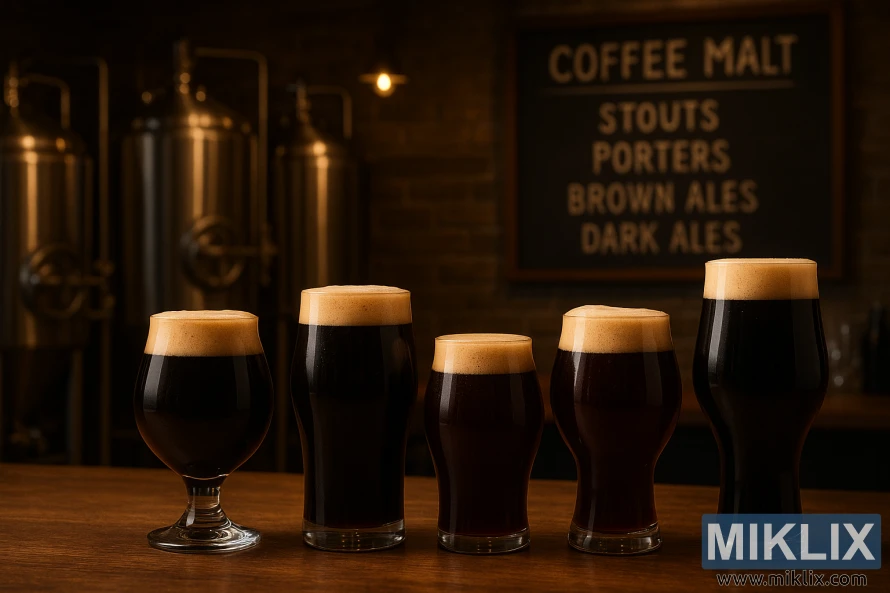
Conclusion
Brewing beer with coffee malt is a complex process. It demands a thorough grasp of brewing fundamentals. This includes choosing the right coffee type, roast level, and brewing method. By excelling in these areas, brewers can craft beers with rich, unique flavors.
Using coffee malt in brewing opens up a world of possibilities for creating distinct beers. The quality of coffee malt, the mash temperature, and water chemistry are all critical. By fine-tuning these elements, brewers can create beers that highlight coffee's sweet, mild roast notes.
In essence, coffee malt brewing is an art that blends traditional brewing with coffee's deep flavors. As brewers experiment with coffee malt, they can invent new beer styles. These styles will attract a broad audience. For those eager to dive into coffee malt brewing, the advice in this article is a starting point. It helps in crafting complex, delicious beers.
Further Reading
If you enjoyed this post, you may also like these suggestions:
